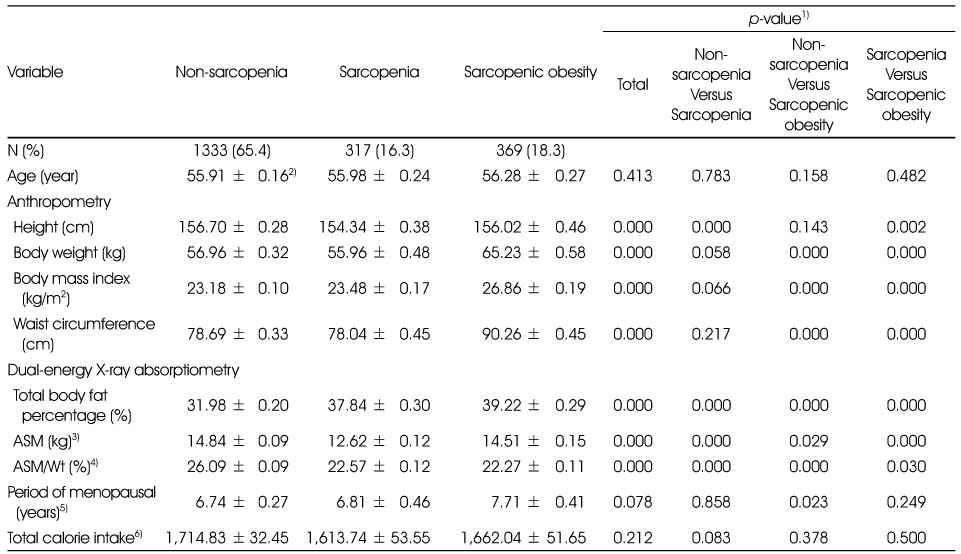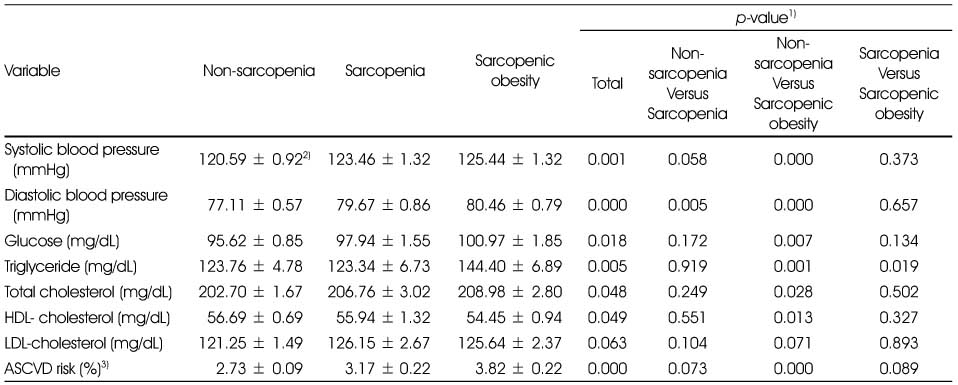Sarcopenia and Sarcopenic Obesity and Their Association with Cardiovascular Disease Risk in Postmenopausal Women: Results for the 2008-2011 Korea National Health and Nutrition Examination Survey
Article information
Abstract
Objectives
This study was conducted to investigate the association between sarcopenia and sarcopenic obesity and cardiovascular disease risk in Korean postmenopausal women.
Methods
We analyzed data of 2,019 postmenopausal women aged 50-64 years who participated in the Korea National Health and Nutrition Examination Survey in 2008-2011 and were free of cardiovascular disease history. Blood pressure, height, and weight were measured. We analyzed the serum concentrations of glucose, total cholesterol, high density lipoprotein cholesterol, low density lipoprotein cholesterol and triglyceride levels. Waist circumference was used to measure obesity. Appendicular skeletal muscle mass was measured by dual-energy X-ray absorptiometry. Sarcopenia was defined as the appendicular skeletal muscle mass/body weight<1 standard deviation below the gender-specific means for healthy young adults. The estimated 10-year risk of cardiovascular disease risk was calculated by Pooled Cohort Equation. Subjects were classified as non-sarcopenia, sarcopenia, or sarcopenic obesity based on status of waist circumference and appendicular skeletal muscle mass.
Results
The prevalence of sarcopenia and sarcopenic obesity was 16.3% (n=317) and 18.3% (n=369), respectively. The 10-year risk of cardiovascular disease risk in the sarcopenic obesity group was higher (3.82 ± 0.22%) than the normal group (2.73 ± 0.09%) and sarcopenia group (3.17 ± 0.22%) (p < 0.000). The odd ratios (ORs) for the ≥7.5% 10-year risk of cardiovascular disease risk were significantly higher in the sarcopenic obesity group (OR 3.609, 95% CI: 2.030-6.417) compared to the sarcopenia group (OR 2.799, 95% CI: 1.463-5.352) (p for trend < 0.000) after adjusting for independent variables (i.e., exercise, period of menopausal, alcohol use disorders identification test (AUDIT) score, income, education level, calorie intake, %fat intake and hormonal replacement therapy).
Conclusions
Sarcopenia and sarcopenic obesity appear to be associated with higher risk factors predicting the 10-year risks of cardiovascular disease risk in postmenopausal women. These findings imply that maintaining normal weight and muscle mass may be important for cardiovascular disease risk prevention in postmenopausal women.
Acknowledgments
This paper was supported by Wonkwang University in 2016.



